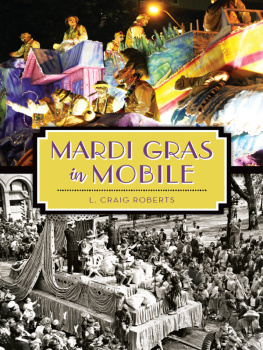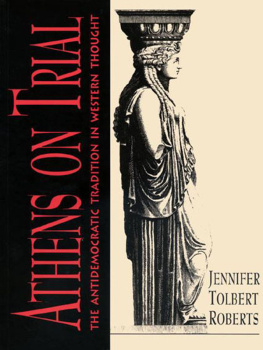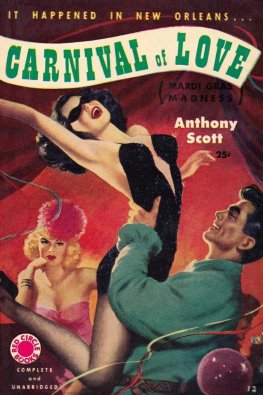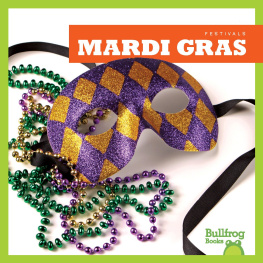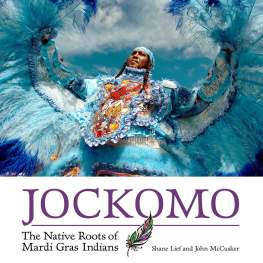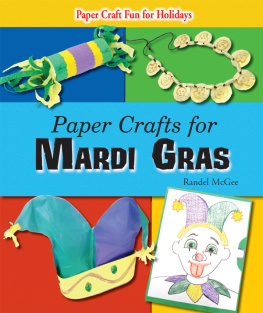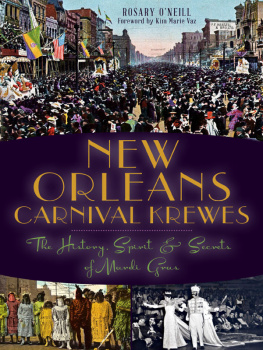

Published by The History Press
Charleston, SC 29403
www.historypress.net
Copyright 2015 by L. Craig Roberts
All rights reserved
Front cover, top: Order of Inca, Theme float, 2011. Courtesy of Steve Joynt / Mobile Mask.
Front cover, bottom: The Kings Float. Mobile Carnival Associations King Felix III and Queen. Courtesy of the History Museum of Mobile.
First published 2015
e-book edition 2015
ISBN 978.1.62585.251.9
Library of Congress Control Number: 2014953423
print edition ISBN 978.1.62619.728.2
Notice: The information in this book is true and complete to the best of our knowledge. It is offered without guarantee on the part of the author or The History Press. The author and The History Press disclaim all liability in connection with the use of this book.
All rights reserved. No part of this book may be reproduced or transmitted in any form whatsoever without prior written permission from the publisher except in the case of brief quotations embodied in critical articles and reviews.
For
the late Madeline C. Partridge
for introducing me to Mardi Gras
and
Rhea S. Mostellar
for the ride
In Mobile, Mardi Gras comes with the seasons, a natural phenomenon, an event to be anticipated and enjoyed, but not really to be considered anything very unusual. One simply grows up knowing that Mardi Gras will come with the spring.
Caldwell Delaney
Contents
Preface
Who is that guy over there? the Old Mobilian asked his friend at a cocktail party. Why, thats Craig Roberts, his friend responded. Hes the new guy who knows all about Mobile. Mind you, I have been here for forty years! I have also been referred to a born-again Mobilian. I like this very much!
Not having been born here, much less having generations of family born here, means one is always considered somewhat of a visitor in Mobile. Visitors and tourists are treated well in Mobile, with all the Southern hospitality, grace and charm you may not expect, and I have been a beneficiary of this same hospitality, grace and charm for almost forty years. Mobile is my adopted city, and I love her. She is like a well-dressed, beautiful and graceful older lady.
As an architect, I am fascinated by Mobiles volume of restored historic buildings and homes. There are more than six thousand listings and six hundred square blocks of historic districts on the National Register of Historic Places.
Equally fascinating as the architecture is the flora and fauna. Majestic live oak treesmany older than our three-hundred-year-old citycanopy our streets for miles in every direction. On them grow Spanish moss, or what I call tropical icicles. Also growing on their branches are resurrection ferns, which dry up and turn brown without precipitation but burst forth in bright chartreuse upon the next rain event. It thrills my senses.
Azaleas, the Indian variety, which grow as big as small houses, are profuse with blooms in March. This is when they light up the city with a fluorescent glow of brilliant pinks, reds and purples. I have often remarked that I have to wear sunglasses to protect my eyes from their blinding color.
Interesting creatures abound. I love the banana spiders (Nephila clavipes) that grow to five inches long and weave webs that by fall would put any horror movie spider web to shame. Alligators? Yes, we have them. You may even hunt them here at specific times. I like to watch the fifteen-footer that suns just outside the dining room at Felixs Fish Camp. Another wonderful reptile, the green anole lizard (Anolis carolinensis), abounds in Mobile. They love to play around your garden sporting their often brilliant green color.
As beautiful as the city is, its greatest treasure may be found in its soul. Its soul is the culture of Mardi Gras. My wish is to open this unique culture to you with this book.
The likely inscription on my Mobile gravestone will read, Here lies L. Craig Roberts, a native of Guntersville, Alabama, who lived here a good while.
Acknowledgements
As a first-time writer, it was imperative that I seek the help of those who are experts in the field about which I write and are also experts in structuring the written word.
My friends at the Mobile Carnival Museum, where I serve as a docent on most Saturdays, were most helpful. Judi Gulledge, executive director of the Mobile Carnival Association and Museum, shared her knowledge and many years of experience from firsthand involvement with Mobiles Carnival. Edward Ladd, curator of the museum, shared many stories of his involvement with our citys great festival and loaned me many books and photographs to which only he has access. Edward Ladd and Tom McGehee were kind enough to proof .
Eric Finley, past president of the Mobile Area Mardi Gras Association, provided me with many wonderful memories, as well as valuable insights into Mobiles African American Carnival history. He worked diligently acquiring the answers to my many questions, as well as providing me with the many contacts needed for my research.
A big thank-you goes to Steve Joynt, editor and publisher of Mobile Mask: The Revelers Guide to Mardi Gras (http://www.themobilemask.com) for sharing articles, photographs and professional insights with me.
I am honored to have friends such as Rhea Mostellar, Rich Gudmundson and David Schmohl. Their knowledge of Mardi Gras societies, parades and the Mobile Carnival Association (MCA) courts was unselfishly shared with me. Equally appreciated was their never-ending patience with me, as I prodded them for information time after time.
The History Museum of Mobile and the Doy Leale McCall and Manuscript Library of the University of South Alabama were generous with their research and time in compiling the many historic photographs I requested and used in this book.
Cartledge Blackwell, with the Mobile Historic Development Commission, was helpful locating important historical photographs.
Mobiles creative world of Mardi Gras design reached out to me, and I will always be grateful to such talented friends as Ron Barrett, Homer McClure and Pat Halsell-Richardson, who opened up their studios, sharing techniques as well as fascinating stories. Craig Stephens and Steve Mussell were so kind to open their secret float barns to me, where they are building next years floats twelve months a year.
Always supportive, my mother, Sue P. Roberts, and sister, Carla R. Hawley, were a great source of positive reinforcement.
My many thanks go to my lifelong friend Forrest Hinton, who tirelessly proofed and corrected my many drafts.
Most of all, my love and appreciation go to my life partner of twenty years, Rob Spicer, for typing page after page of handwritten text and then re-typing edited drafts.
Introduction
If you read nothing else, read these ten facts about Mardi Gras in Mobile.
1. MARDI GRAS IS THE DAY; CARNIVAL IS THE SEASON.
Mardi Gras means Fat Tuesday in French. It is Shrove Tuesday, the day before Lent begins (Ash Wednesday). Carnival is all the parades, balls and parties leading up to Mardi Gras Day.
2. MOBILE WAS THE FIRST CITY IN THE WESTERN HEMISPHERE TO CELEBRATE MARDI GRAS.
The French settled Mobile first along the Gulf Coast. They had settled Canada before, but it was too cold to have Mardi Gras there.
3. MOST MARDI GRAS PARADES PRECEDE A BALL.
Next page
